2014: Alaska Airlines employees emerge as heroes after the hurricane in Los Cabos
Share
Hurricane Odile was bad. The aftermath was even worse.
Amid the devastation and destruction, one bright spot was the response from Alaska Airlines employees who lent a hand when it was needed most.
In the week since the storm slammed into Los Cabos, people who were evacuated on Alaska’s humanitarian relief flights have started to share stories of gratitude for employees – on the ground and in the air – who went above and beyond.
“You have no idea what we went through – it was simply terrifying,” one traveler wrote in a post-flight survey. “Your staff was amazing – hugging us, comforting us, humoring us, and delighting us with supreme service. It wasn’t just one person, it was the entire staff.”
Through their heroic actions, employees showed the world what it means to say, “I am Alaska.”
Getting the job done in ‘horrendous’ conditions
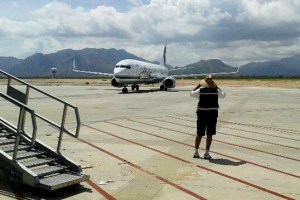
Many of the 25 Alaska employees who live in Los Cabos put aside their own adversity and showed up for work at the airport for three days to help people fly back to the United States.
The Alaska Airlines humanitarian relief flights, dubbed Operation Ayuda – “help” in Spanish – consisted of two parts: taking food and water into Los Cabos and bringing people out.
Alaska delivered 24 tons of supplies, including 36,000 liters of water, into Los Cabos and brought home about 2,000 visitors who were stranded.
Aboard the flights back, crews comforted those who emerged from chaotic and confusing conditions. Free cheeseburgers and cold drinks helped, too.
“You felt like you were flying your own family out of danger,” said flight attendant Dawn Vermeulen. “We felt like one big family, and everybody was just so nice to us. We treated them like gold. I think Alaska is just the greatest airline.”
In San Diego, when people in line at Customs saw the flight attendants, they gave them a standing ovation. Many had tears in their eyes.
 “Thank you for being the first airline to come and evacuate us, nurture us, take care of us until we reached our destination,” one person wrote in an email. “The in-flight team was more than friendly, patient and understanding with us and it was such a cute, generous gesture for the flight attendants to give us a gum packet on each of our seats welcoming us back. It literally brought tears in my eyes and I knew I was going to be in good hands with Alaska.”
“Thank you for being the first airline to come and evacuate us, nurture us, take care of us until we reached our destination,” one person wrote in an email. “The in-flight team was more than friendly, patient and understanding with us and it was such a cute, generous gesture for the flight attendants to give us a gum packet on each of our seats welcoming us back. It literally brought tears in my eyes and I knew I was going to be in good hands with Alaska.”
Another couple on their honeymoon had return tickets on another airline, but Alaska employees welcomed them with open arms.
“The only question your crew asked of us was, ‘Do you want to go home?’ A resounding YES with tearful eyes was our reply,” they wrote. “Thank you for your kindness, compassion and the cheeseburger.”
With the temporary closure of the Los Cabos International Airport, the focus now turns to the long-term wellbeing of Alaska Airlines employees who live in Los Cabos, the rebuilding process for the community, and a commitment to help restore tourism when the area is back on its feet.
Living through the storm
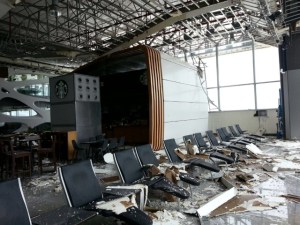
Alaska Airlines employees in Los Cabos say Hurricane Odile was unlike anything they’d ever experienced.
“The wind was so strong that water was entering between the gaps in the windows and doors as if there was a hose in the other side,” said Edgard Aguilar, customer service manager in Los Cabos. “The sound outside was like a big airplane landing next door. The amount of water at moments was like if I had someone pouring buckets over my roof. So much water and so much wind that I thought I was living a doomsday movie.”
Travelers who experienced the storm shared their stories with Danny Flores, customer service manager in San Diego.
“One man said he’ll be traumatized for years because of what happened,” Flores said. “Another said he experienced Hurricane Katrina and this was much worse.”
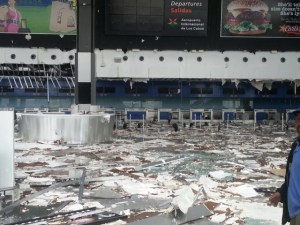
At the airport, the storm blew out windows, ripped apart the ceiling and caused severe water damage. Alaska had moved into the shiny new Terminal 2 at Los Cabos less than two years ago. After the storm, the terminal was uninhabitable.
Power, water, Internet, landline and cell phone services were knocked out. Roads were impassable. Many employees reported that their homes were damaged and flooded – mostly broken windows, soaked furniture and lost water tanks.
One customer told flight attendant Beverly Sadeghi that the hurricane turned their hotel into a scene from “Titanic” – water rushed down the stairs as they tried to run down a hallway in knee-deep water. They had to leave everything behind to get out as fast as possible.
At daylight, customers started to make their way to the airport.
On the ground evacuation
In the immediate aftermath of the storm, a top priority was establishing communication to let the outside world know what happened.
 Aguilar, who lives near the airport, borrowed a satellite phone from an arriving member of the Mexican military, and was able to speak briefly with Francisco Albiter, general manager of government relations and finance, in Mexico City. Albiter relayed the information to System Operation Control in Seattle and Rick Hines in Los Angeles, director of customer service-airports and station operations in the southern region that includes Mexico.
Aguilar, who lives near the airport, borrowed a satellite phone from an arriving member of the Mexican military, and was able to speak briefly with Francisco Albiter, general manager of government relations and finance, in Mexico City. Albiter relayed the information to System Operation Control in Seattle and Rick Hines in Los Angeles, director of customer service-airports and station operations in the southern region that includes Mexico.
The call was cutoff but the message was clear: Los Cabos needed help.
As the enormity of the situation began to become apparent, Alaska Airlines began developing a plan to send relief flights. Before one meeting ended, SOC Director Wayne Newton had one important question.
“Are we being safe?” he asked the group.
There were no objections.
“Let’s do this,” he said.
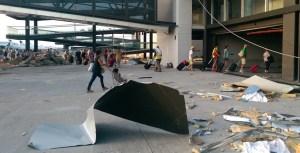
Employees on that first Alaska Airlines plane into Los Cabos didn’t know exactly what to expect when they landed, but they knew it would be bad. The plane was fueled for a round-trip and carried 16 Alaska employees to help out on the ground: customer service agents, ramp agents, a maintenance technician, and IT employees with computer equipment and satellite phones.
Luis Perez, a contract service lead from Long Beach, was on one of the relief flights. On the way to Los Cabos, a plan was developed with ground operations manager Mike Crawford, who offered him some guidance about what to expect when they landed.
“Keep in mind that the conditions we’re up against will be different than what we’re planning,” Crawford said.
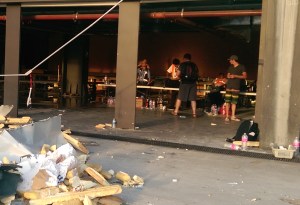
When the aircraft door opened, Perez found out what Crawford was talking about.
“It was sensory overload,” Perez said. “The first thing I did was check on our employees and made sure they had some snacks to keep them going because without them, we couldn’t get the people on our flights. Second was pause for a moment and see what they had set up to processes passengers and bags. Once I saw that they had that area taken care of, I focused my attention to the passengers.”
With so much debris on the ground, simply walking was a challenge.
“I cannot stress enough how surreal this entire experience was,” Hines said. “To see the total destruction, the masses of humanity who were confused and dazed and sunburned, with different degrees of heat exhaustion and heat stroke. No running water, no bathrooms.”
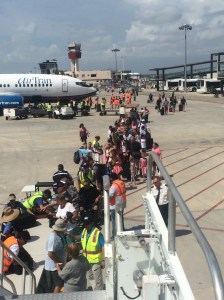 In all the chaos, the faces of employees are what Hines remembers most.
In all the chaos, the faces of employees are what Hines remembers most.
“Their eyes were just big, almost like shock,” Hines said. “Scared and shocked, but absolutely engaged in the overall effort. Their faces are just kind of etched inside my brain.”
Alaska team members went back into the destroyed terminal to find tables so they could set up a bag-search area.
“I am so proud of our team came together and formulated a plan in quick fashion, then went out and created a safer area to work by sweeping and removing debris,” Hines said. “They created a place for people to get out of the hot sun. They took a very chaotic, disorganized situation and created organization and a process to move people through this.”
Hines tells the story of Mayra Tirado, customer service supervisor in Los Cabos. In the early hours after the hurricane, communication was nearly impossible. So Aguilar directed Tirado to go to Mazatlan so she could call Alaska leaders and let them know what was going on.
“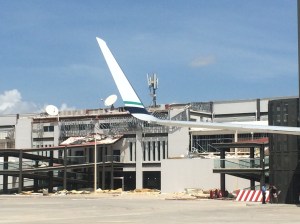 Mayra didn’t want to leave her team,” Hines said. “She knew her team needed her and she knew Edgard needed the support as well. Edgard finally had to direct her to go, which turned out to be a solid leadership call. If Mayra hadn’t called us to provide us with a much clearer picture of exactly what was happening in Los Cabos, our response could have been delayed.”
Mayra didn’t want to leave her team,” Hines said. “She knew her team needed her and she knew Edgard needed the support as well. Edgard finally had to direct her to go, which turned out to be a solid leadership call. If Mayra hadn’t called us to provide us with a much clearer picture of exactly what was happening in Los Cabos, our response could have been delayed.”
After one of the first evacuation flights, employees who returned to Los Angeles brought with them a shopping list of items that were badly needed by employees in Los Cabos. They worked through the night and spent thousands of dollars filling the orders. Many other employees worked behind the scenes to backfill positions of those who worked the special relief flights.
When the team from Los Angeles returned to Los Cabos, they brought CamelBak packs full of water and strapped them onto the backs of employees on the ground, so they could try to stay hydrated as they worked.
Perez made sure customers had water and that children had snacks and liquids to keep them going.
“I found myself getting emotional various times that day, especially when we would tell groups of people that we had a flight and we were able to accommodate them and fly them out,” Perez said. “Looking back at this experience it makes me proud of Alaska Airlines and my fellow co-workers on how we can come together in times of need and give our time, sweat and tears to help not only our fellow employees but anybody in need.”
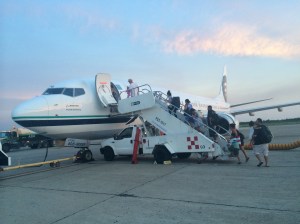
During relief operations, Alaska Airlines evacuated about 2,000 people — a mix of customers and people from other airlines.
“We had a water in their hand before they even sat down,” said Vermeulen, the flight attendant. “All of us were so happy to make them happy. It just touched your heart. We just saved these people and now they can relax and sit back.”
During the food and beverage service, one customer said he didn’t have any money.
“We don’t need any money,” Vermeulen replied. “We would like you to have this compliments of Alaska Airlines. They were crying. You hugged them and just listened to their stories. We took these people from tears to cheers – they’re happy, they’re home, they’re safe.”
When the boarding door closed, customers cheered.
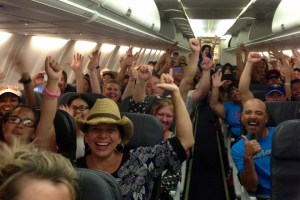
“They cheered again once we took off, and cheered, clapped, and whistled once the captain announced our final descent into San Diego,” Sadeghi said. “Once we landed, there was a riot of cheering, clapping, people laughing, and crying as they returned to the U.S.”
In all, nine relief flights carried 1,549 people out of Los Cabos. Two relief flights carried 229 people out of Mazatlan. A relief flight out of Loreto carried 140 people.
“Once we had all the passengers boarded on the flight to L.A., one of the women started crying,” said flight attendant Rodrick Massey. “I asked her why she was crying and she said, ‘We’re going to L.A.? I thought we were going to Tijuana.’ There had been so much chaos at the airport that she didn’t even know where she was headed.”
Taking care of employees in the aftermath
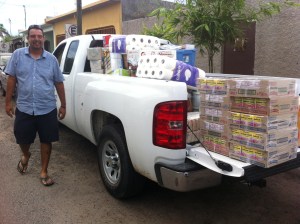
In Los Cabos, local crews are working this week to restore water and electricity.
“A few banks and stores have reopened, so hopefully in a couple weeks or less we should have a sense normalcy,” Aguilar said.
For employees and their families who live in the Los Cabos area, volunteers from the Alaska Airlines Critical Incident Response Program will offer assistance and determine whether they have any special needs as they cope with the stress of the storm. The CIRP team helps people talk about and process their reactions to tragedy, as well as provide information on stress responses and self-care.
“We want to make sure we’re giving employees the emotional support that I know a lot of them are going to need,” Hines said.
In Mexico, stations are rallying to deliver supplies to their counterparts in Los Cabos.
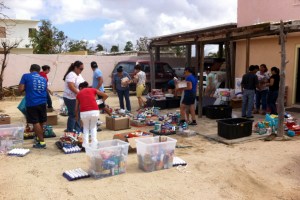
On Monday, Aguilar, Francisco Albiter and Krystal Crespo drove a truckload of food, diapers, baby formula and other essentials requested by employees. They met with employees in Los Cabos to discuss airport recovery efforts and determine the losses that each employee suffered in the hurricane.
Alaska Airlines has donated $30,000 to Alaska’s Employee Assistance Fund to help employees who live and work in Los Cabos, and the EAF has matched corporate donations to the “Los Cabos Hurricane Relief Fund,” for a total of $60,000. Alaska also donated $20,000 to the Red Cross to help with relief efforts.
“This was a devastating natural event, but Alaska shined brightly in the aftermath,” said Alaska CEO Brad Tilden. “I am in complete awe at the way our folks came together and responded. Thank you so much.”
Many employees were relieved to learn that Alaska Airlines will maintain their wages for at least 90 days, and will continue to review the next steps after that.
“I sensed a lot of relief and hope,” Aguilar said. “We removed a weight off of their shoulders and I heard words of appreciation and gratitude.”
Mexico’s Dirección General de Aeronáutica Civil – similar to the FAA – closed Los Cabos International Airport to focus efforts on repairs. (Update: Alaska Airlines plans to resume flights to Los Cabos from Los Angeles on Oct. 8.)
“Alaska Airlines has been a big supporter of Los Cabos for 25 years,” said Andrew Harrison, senior vice president of planning and revenue management. “We have a lot invested in the region and as soon as they’re back on their feet, we’ll be back.”
When the airport reopens, Alaska Airlines will be there. With employees on the ground, Alaska never really left.
“I think of all the heroes who emerged from this,” Hines said. “Many of our employee sustained damage to their homes, suffered personal losses and have families to care for. The majority of our Cabo employees put aside their own personal needs and came to work each day to serve our customers. The conditions were rough, food and water was hard to come by, the weather was hot and humid, yet they worked 10 or more hours each day to serve others. That was heroic. And that is something I will never forget.”
UPDATE: Alaska Airlines returns to Los Cabos, Mexico

